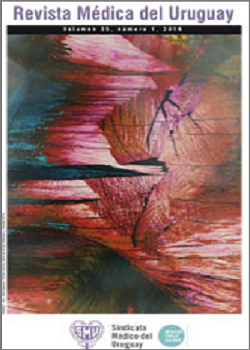Budd-Chiari syndrome associated to antiphospholipid syndrome
Abstract
Introduction:
Budd-Chiari is a rare condition characterized by the occlusion of the hepatic vein flow out. It is frequently associated to a pro-thrombotic state. Diagnosis and treatment constitute a challenge for clinical doctors. This study aims to report a clinical case of Budd-Chiari syndrome secondary to an antiphospholipid syndrome, a rather unusual association in literature.
Clinical case:
31 year old woman, with 6 years of evolution ascites, evidencing a general affection in the last year. Clinical examination: lucid, universal hyperbilirubinemia (jaundice), painful hepatomegaly, splenomegaly and tension ascites. Laboratory tests: hepatogram with cholestatic pattern, cholinesterase, and reduced prothrombin rate. Abdominal Doppler revealed: severe ascites, irregular hepatomegaly, increased echogenicity. Splenomegaly. Occlusion of the middle suprahepatic vein, narrowing of the right suprahepatic vein. Llow speed scarcely phasic flow, inverse in a few branches, hepatofugal. Fibrogastroduodenoscopy: esophagic varices grade III. Ascites secondary to portal hypertension was suspected, probable Budd Chiari syndrome. Antibodies IgM â2glicoprotein 1 were positive. Diagnosis of antiphospholipid syndrome. Liver transplant was performed with a good evolution of the patient.
Discussion and conclusions:
Budd-Chiari syndrome is more frequent in women between 35 and 50 years old. It needs to be regarded as a cause of liver conditions, in particular when there is no other evident cause. Hematologic diseases are the prothrombotic states more frequently associated to Budd-Chiari syndrome in the western world. Treatment must be based on the clinical presentation. Liver transplant is a rescue/salvage measure when all other treatments fail.
References
(1) European Association for the Study of the Liver. EASL Clinical Practice Guidelines: vascular diseases of the liver. J Hepatol 2016; 64(1):179-202.
(2) Menon KV, Shah V, Kamath PS. The Budd-Chiari syndrome. N Engl J Med 2004; 350(6):578.
(3) Liu L, Qi XS, Zhao Y, Chen H, Meng XC, Han GH. Budd-Chiari syndrome: current perspectives and controversies. Eur Rev Med Pharmacol Sci 2016; 20(15):3273-81.
(4) Ferral H, Behrens G, Lopera J. Budd-Chiari syndrome. AJR Am J Roentgenol 2012;
(4):737-45.
(5) Valla DC. Primary Budd-Chiari syndrome. J Hepatol 2009; 50(1):195-203.
(6) Buzas C, Sparchez Z, Cucuianu A, Manole S, Lupescu I, Acalovschi M. Budd-Chiari
syndrome secondary to polycythemia vera. A case report. J Gastrointestin Liver Dis 2009; 18(3):363-6.
(7) Aydinli M, Bayraktar Y. Budd-Chiari syndrome: etiology, pathogenesis and diagnosis. World J Gastroenterol 2007; 13(19):2693-6.
(8) Khamashta M. Síndrome antifosfolipídico. En: Farreras P, Rozman C. Medicina Interna. 18ª ed. Barcelona: Elsevier, 2016: 1045-47.
(9) Uthman I, Noureldine MHA, Ruiz-Irastorza G, Khamashta M. Management of antiphospholipid syndrome. Ann Rheum Dis 2018. doi: 10.1136/annrheumdis-2018-213846.
(10) Espinosa G, Font J, García-Pagan JC, Tàssies D, Reverter JC, Gaig C, et al. Budd-Chiari syndrome secondary to antiphospholipid syndrome: clinical and immunologic characteristics of 43 patients. Medicine (Baltimore) 2001; 80(6):345-54.
(11) Iadevaia M, Del Prete A, Cotticelli G, De Sio I, Niglio A, Loguercio C. Budd-Chiari syndrome as a manifestation of antiphospholipid antibody syndrome during oral
contraceptive therapy: more to think about. J Liver 2013; 2:129.
(12) Chinen N, Koyama Y, Sato S, Suzuki Y. A case of acute Budd-Chiari syndrome complicating primary antiphospholipid syndrome presenting as acute abdomen and responding to tight anticoagulant therapy. Case Rep Rheumatol 2016:9565427. doi: 10.1155/2016/9565427.
(13) Sebastiani M, Manzini CU, Campomori F, Spinella A, Vacchi C, Giuggioli D, et al. Unusual association between Budd-Chiari syndrome secondary to antiphospholipid syndrome and relapsing polychondritis: a case report and review of the literature. Clin Rheumatol 2013; 32(6):905-7.
(14) Rand JH, Wolgast LR. Dos and don'ts in diagnosing antiphospholipid syndrome. Hematology Am Soc Hematol Educ Program 2012; 455-9.
(15) Tincani A, Andreoli L, Casu C, Cattaneo R, Meroni P. Antiphospholipid antibody profile: implications for the evaluation and management of patients. Lupus 2010; 19:432-5.
(16) Brusch A. The significance of anti-beta-2-glycoprotein i antibodies in antiphospholipid syndrome. Antibodies 2016; 5(2):16.
(17) Mancuso A. An update on management of Budd-Chiari syndrome. Ann Hepatol 2014; 13(3):323-6.
(18) Solari J, Bandi J, Galdame O, Marciano S, Mullen E, Garcia MR, et al. Diagnóstico, tratamiento y evolución del síndrome de Budd-Chiari: experiencia de un centro. Acta Gastroenterol Latinoam 2010; 40:225-35.
(19) Witte AM, Kool Lj, Veenendaal R, Lamers CB, van Hoek B. Hepatic vein stenting for Budd-Chiari syndrome. Am J Gastroenterol 1997; 92(3):498-501.
(20) Tavill AS, Wood EJ, Kreel L, Jones EA, Gregory M, Sherlock S. The Budd-Chiari syndrome: correlation between hepatic scintigraphy and the clinical, radiological, and pathological findings in nineteen cases of hepatic venous outflow obstruction. Gastroenterology 1975; 68(3):509-18.
(21) Darwish Murad S, Plessier A, Hernandez-Guerra M, Fabris F, Eapen CE, Bahr MJ, et al. Etiology, management, and outcome of the Budd-Chiari syndrome. Ann Intern Med 2009; 151(3):167-75.













